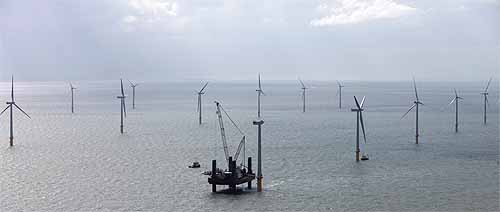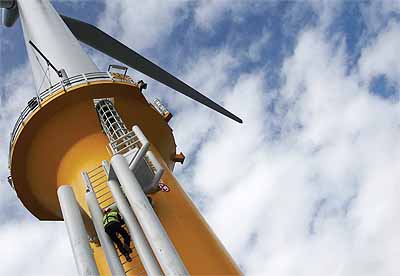Siemens Energy, Wind Power Business Unit
A powerful future for Siemens
Last time Manufacturing Today Europe spoke to Siemens Energy the company was predicting huge potential for growth in the wind industry.
This was due to the realisation that wind energy is increasingly appealing, especially with regards to rising oil prices and energy security. This prediction has been realised, as Henrik Stiesdal, chief technology officer of the Siemens Wind Power Business Unit comments: “Over the past few years the company has grown annually by about 40 per cent and this looks set to continue.”
In addition, the company has recently received one of its largest contracts to date. In May, Siemens gained an order for 140 wind turbines for the world’s largest offshore wind farm. The contract will see the business supply turbines with a capacity of 3.6 megawatts each. They will be delivered to the future world’s largest offshore wind farm, Greater Gabbard, located 25 kilometres off the coast of Suffolk in the UK. The delivery of these turbines is scheduled in 2009 and 2010, and the order also includes a five-year service and warranty agreement.
The Greater Gabbard offshore wind farm will be the first in the UK to be built outside territorial waters. It will produce electricity with a maximum capacity of 500 megawatts, and will provide green electrical power for more than 415,000 homes. The wind turbines of type SWT-3.6-107 will be mounted on steel monopiles, in water depths between 24 and 34 metres. Achieving this significant contract marks a major milestone in the offshore business for Siemens – the clear market leader in the offshore wind energy market.
maximum capacity of 500 megawatts, and will provide green electrical power for more than 415,000 homes. The wind turbines of type SWT-3.6-107 will be mounted on steel monopiles, in water depths between 24 and 34 metres. Achieving this significant contract marks a major milestone in the offshore business for Siemens – the clear market leader in the offshore wind energy market.
Siemens offers innovative solutions that use highly efficient and reliable wind turbines to harness natural wind energy to provide a sustainable source of renewable power. Previously operating as Bonus Energy, the Siemens Wind Power Business Unit is part of the Renewable Energy division of the Energy Sector of Siemens, a prominent company in the international power generation sector providing cutting-edge energy solutions.
The first offshore project using Siemens’ 3.6 megawatt turbines was the Burbo Bank offshore wind farm, which is situated on the Burbo Flats in Liverpool Bay at the entrance to the River Mersey. Siemens supplied and installed 25 efficient turbines to the farm, which is operated by SeaScape Energy, a company owned by DONG Energy. Due to its strong winds and shallow depths, Burbo Banks is an excellent location for a wind farm.
Henrik comments: “These turbines were installed last year and they are running very well. We are gaining a significant amount of experience from this project, especially with regards to the testing of the grid performance. In the future, wind farms need to be able to act more like power stations and regulate automatically in case of changes in demands or disturbances on the grid. Therefore, we have carried out tests at Burbo, where we have developed a very advanced regulation system. This has been extremely successful, and we feel that we have demonstrated that a wind farm can do exactly what the grid system operators need, which is to regulate in response to events on the grid.”
As the world’s oldest existing wind turbine manufacturer, Siemens is continually evolving in order to meet the changing demands of the wind industry. One of the main trends in the market at the moment is that wind power is now also being exploited in areas of relatively moderate wind resources. To address this problem, the company is investing in the development of a larger rotor for the SWT-2.3-93 wind turbine. Henrik explains: “The rotor for this machine has been gradually growing over the years – in 2002 it was 82 metres, which grew to 93 metres in 2005. We are now developing a 101-metre rotor, which will be able to serve the lower wind markets. We will be installing a prototype later this year in Denmark and another in the US, in a location with very strong winds, to test our the machine under extreme conditions.”
As a result of the growth of the company and its investment into new technologies, Siemens’s main challenge is to ensure it can produce components fast enough, whilst retaining its reputation for high quality. Henrik continues: “The key to achieving this is building strong supplier relationships. Over the years, we have developed long-term partnerships with our main component suppliers. We have been working with most of them for around ten to 20 years, and together we have experienced both the good and bad times. We work together and develop a strategy, which is built around communication and sharing issues and problems. Consequently, we can develop clear targets for the future of the business.”
It is these strong partnerships with both its suppliers and customers that have helped Siemens to progress profitably and efficiently. As an example, the business is currently working in partnership with StatoilHydro, a merger of the national Norwegian energy company and Norsk Hydro, an international supplier of energy and aluminium, to develop the world’s first floating wind turbines. “StatoilHydro has recently formally approved the investment, which will be about £30 million. The main target now is to have the first floating turbine installed by the end of 2009,” Henrik comments.
“For conventional foundations, the maximum economical water depth is on the order of about 50 metres – this means that you cannot use large areas of the seabed, especially around the UK because the depth is too large. The beauty of the StatoilHydro idea is that the turbine doesn’t have to be firmly embedded in the sea floor. As a result, we will be able to place turbines at any water depth, which will hugely increase available sea areas. It is an extremely simple idea and reduces costs to an absolute minimum as it’s just a floating upright cylinder with a big counter weight at the lower end and three anchor lines,” he adds.
This excellent partnership with StatoilHydro is just one of the elements in Siemens’ expansion potential and security in the future wind market. Henrik concludes: “We predict strong and profitable growth over the next few years, onshore and offshore. Increasing concerns over climate change, oil prices and energy security means that demand for alternative energy sources is currently booming. This is excellent news for us and our main vision is to optimise these opportunities with continuous improvement of our products and our business.”
Siemens Energy, Wind Power Business Unit
Products: Wind turbines
Sites: Denmark and the US
Employees: 4000
www.siemens.com/energy
